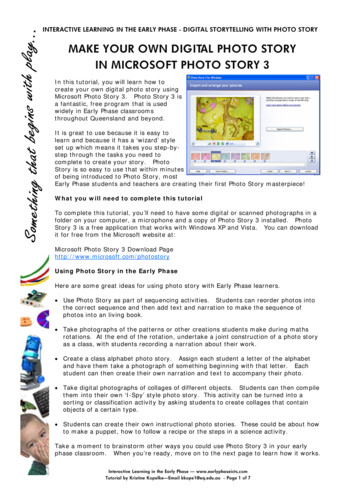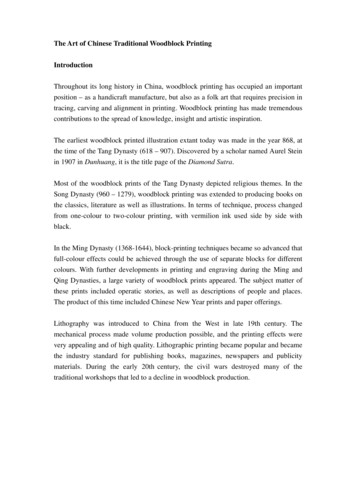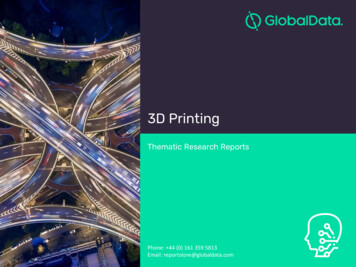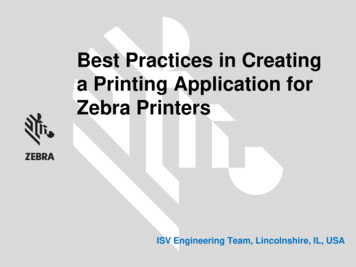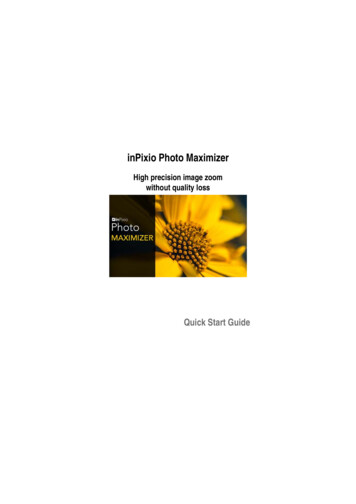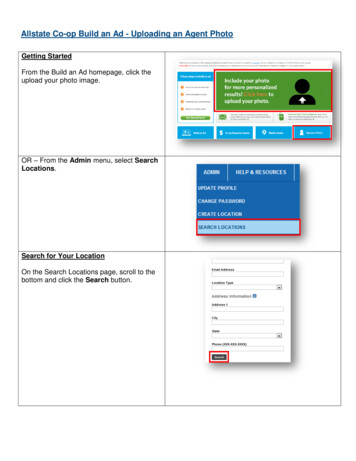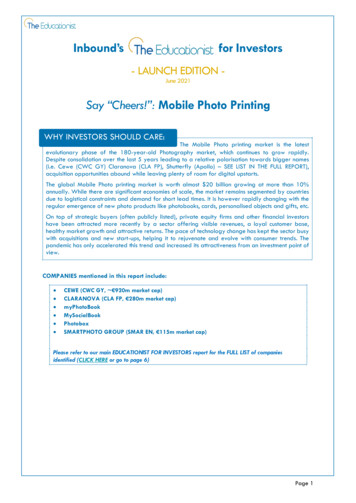
Transcription
Inbound’sfor Investors- LAUNCH EDITION June 2021Say “Cheers!”: Mobile Photo PrintingWHY INVESTORS SHOULD CARE:WHY INVESTORS SHOULD C.The Mobile Photo printing market is the latestevolutionary phase of the 180-year-old Photography market, which continues to grow rapidly.Despite consolidation over the last 5 years leading to a relative polarisation towards bigger names(i.e. Cewe (CWC GY) Claranova (CLA FP), Shutterfly (Apollo) – SEE LIST IN THE FULL REPORT),acquisition opportunities abound while leaving plenty of room for digital upstarts.The global Mobile Photo printing market is worth almost 20 billion growing at more than 10%annually. While there are significant economies of scale, the market remains segmented by countriesdue to logistical constraints and demand for short lead times. It is however rapidly changing with theregular emergence of new photo products like photobooks, cards, personalised objects and gifts, etc.On top of strategic buyers (often publicly listed), private equity firms and other financial investorshave been attracted more recently by a sector offering visible revenues, a loyal customer base,healthy market growth and attractive returns. The pace of technology change has kept the sector busywith acquisitions and new start-ups, helping it to rejuvenate and evolve with consumer trends. Thepandemic has only accelerated this trend and increased its attractiveness from an investment point ofview.COMPANIES mentioned in this report include: CEWE (CWC GY, 920m market cap)CLARANOVA (CLA FP, 280m market cap)myPhotoBookMySocialBookPhotoboxSMARTPHOTO GROUP (SMAR EN, 115m market cap)Please refer to our main EDUCATIONIST FOR INVESTORS report for the FULL LIST of companiesidentified (CLICK HERE or go to page 6)Page 1
INVESTORS’ ESSENTIAL: MOBILE PHOTO PRINTING IN A NUTSHELLThe Global Photo Printing Market, once dominated by Kodak – owned by EASTMAN KODAK Co (KODK US, 700m market cap) and Fujifilm – owned by FUJIFILM HOLDINGS Corp (4901 JP,Y3.2tr), has undergoneenormous changes in the last few decades. The advent of digital photography turned the market upside down,with competitors scrambling for survival and new entrants disrupting old ways of competing. Mobile digitalcameras dominated for a while, but the industry was again shaken up with the addition of good qualitycameras to mobile phones which allowed users to document their lives far more easily than before. For manytaking and storing digital photographs, or sharing them on social media seems ideal, however, a tangibleprint has special significance and is frequently used as a personalized gift. It immortalises memorable moments,be it on paper or other gifts. Being able to print from mobile devices has evolved rapidly too and has had amajor impact on the industry.What is Mobile Photo Printing?Mobile Photo Printing is a service that allows users to conveniently order high quality prints on their smartphonefrom a professional printer and have them delivered to their door in less than 48 hours. Providers temptcustomers with premium products such as posters, photobooks, t-shirts, keyrings, mugs etc. The advantages overhome printing are: Cost: there are significant scale economies for ink, paper, and printing equipment.Quality: professional printing is invariably better than home printingMedia: printing need not be confined only to paper in standard sizes but can apply to gifts andmemorabilia (premium products benefit from higher margins).Convenience:o No trip to a store or kiosko No hassle of running out of printer ink and swapping out photo quality paperSmartphone as a photo hub: Mobile apps help with the tedium of selecting and formatting thethousands of photos that individuals now accumulate in their phone and in the cloud. This is all thetruer as smartphones are becoming the main if not the only instrument to take photos and videos.Page 2
Source: Inbound CapitalSmart phones the triggerAs home printing became expensive in terms of both money and time as individual households soondiscovered the hidden costs of home-printing. Furthermore, the convenience of smartphone and socialmedia led to an explosion of photography, and users found themselves overwhelmed by the sheerquantity of pictures being taken.Source: CEWEPage 3
Web Based PrintingThe explosion of photo taking led to the re-intermediation of photo printing businesses. Phone appswere developed to streamline the process, and professional printers offered new printing media notavailable to households such as photo-books, t-shirts, and posters.The sales’s history of CEWE also demonstrates these trends.Source: CEWEValue ChainThe value chain from photo-taking to obtaining a print has evolved over the last 40 years as new technologyhas been introduced.Source: Inbound CapitalOver time, the value chain has grown as more value-added steps have been introduced with the advent ofdigital technology. Interestingly, at the turn of the century there was a shift away from professional printingthat was subsequently reversed by social trends and new mobile technology.Page 4
Mobile photo printing has also benefited significantly from the introduction of more efficient digital printingtechnologies and processes by professional and industrial printers. While offset printing was previously themost popular printing press technique, digital printing, which offers the flexibility required for printingindividual photos, has been a major boost for the industry.The difference between offset and digital printingDigital printerOffset-printPrints from a digital-based image directly topaper. It requires no set-up time but is prints at aslower rate compared to off-set printingAdvantages: Setup costs are lower for short runs Print only the amount needed, when needed Lower minimum quantities (as low as 1) Inexpensive black and white digital printing Variable data capability (names, addresses,codes or numbering can be done easily) Improved technology has made digitalquality acceptable for more usesUses plates, usually made from aluminium, which areused to transfer an image onto a rubber "blanket",and then rolling that image onto a sheet of paper. Large quantities can be printed costeffectivelyFaster printingA large variety of paper types with customfinishes can be usedSource www.printingforless.comPage 5
WANT MORE? MOBILE PHOTO PRINTING IN DETAILGet our main EDUCATIONIST FOR INVESTORS report on MOBILE PHOTO PRINTING by contacting:contact@inbound.capitalThe full 29-page version of THE EDUCATIONIST includes Company Snapshots and our extendedlist of companies identified in the space, and covers the following topics:The Market1. Mobile photo printing market2. Photobook and personalised gifts marketSector Developments1.2.3.4.5.6.Growth in photo-takingCloud Applications transforming smartphones as a photo hubMobile ordering platformsNew productsCustomer productivity improvements & supportRecent business modelsTrends to watch1.2.3.4.5.6.The Forever Demand for Increasing QualityArtificial IntelligenceSecurityVoice ControlInternet of ThingsSustainability/ESGCovid 19 ImpactCompany SnapshotsPrivate Equity BuyersMain transactionsExtended list of companies (listed, private and start-ups)AppendixPage 6
About Inbound CapitalInbound is an independent corporate advisor for Small/Mid-caps and start-ups. Capitalising on theexpertise of its team of senior equity professionals based in London, Paris and New York, and thanks toits unique network of international investors and tiers-1/tiers-2 research houses, Inbound offers a fullrange of outsourced investor relations services, as well as capital raising services for start-ups. InboundCapital is regulated by the Financial Conduct Authorities (FCA).For more information about Inbound Capital, visit our website: www.inbound.capitalDISCLAIMERInbound Capital provided investor relations services to Claranova.Page 7
The Global Photo Printing Market, once dominated by Kodak - owned by EASTMAN KODAK Co (KODK US, 700m market cap)and Fujifilm - owned by FUJIFILM HOLDINGS Corp (4901 JP,Y3.2tr), has undergone enormous changes in the last few decades. The advent of digital photography turned the market upside down,


